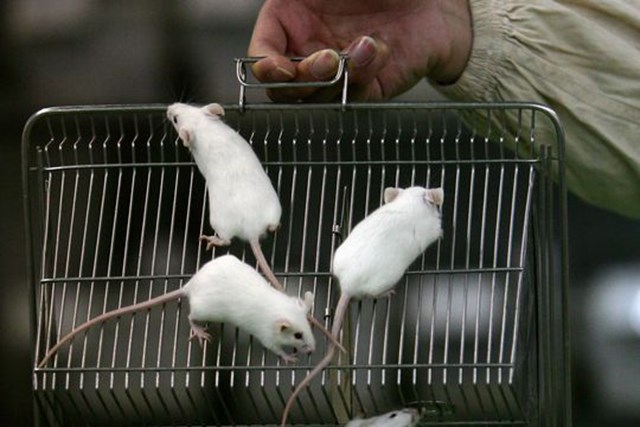Old rats get bones by injecting blood from young mice
By injecting the blood of young mice into older mice, scientists at the University of Toronto found that their ability to heal bones would be many times faster than normal.
Suddenly old rats were bone-like thanks to the blood of young mice
This finding promises to be applicable to people, creating drugs that help the healing process more quickly, improve some functions that get worse with age or even reverse the process. old. The study was published in the recent Nature journal.

According to statistics from the US public health organization, the proportion of people suffering from hip injuries each year is 1/5 and the rate of hip injuries increases rapidly with age: people over 85 years old have billions Hip injury rates are 10 to 15% higher than those aged 60-65 years. Therefore, understanding the mechanism of bone healing after injury is extremely important, especially for the elderly, this is the key to help save their lives.
In the study, scientists injected blood from young mice into older individuals with broken bones. Later, they found that older mice that were "transfused " had faster bone healing time than other normal mice. And even, the healing time is as fast as when they were young. To narrow the scope of the study to understand the nature of the problem, they continued to transplant bone marrow from young mice to old mice and the results were similar.
Previous studies have shown that the beta-catein protein is directly related to the ability to heal post-traumatic bone. As you age, mice will produce more of these proteins. To test it again, the researchers used old mice with broken bones, but with low levels of beta-catein, they were ultimately able to heal as quickly as the "young man". . Combining all three trials, the team confirmed that beta-catenin is the key to the problem.
Biologist Benjamin Alman of the University of Toronto, co-author of the study, said: "Our most important finding is that as we age, cells that heal bones do not lose the ability to heal injuries. In fact, they can be stimulated to make this possible, which promises to develop into a "rejuvenating ability to heal bone", he said, adding that in the past, people had produce drugs that work with beta-catenin protein.
However, a cell biologist at Mayo Hospital Christopher Evan thinks that you don't expect too much on a fast bone healing drug: " The aging aspect of animals depends on many factors, not just In addition, the results of this study also note that the concentration and timing of beta-catenin signaling must be done carefully and accurately to achieve the desired healing effect. This is a challenge when applied in the form of medicines. "
On the other hand, Evan thinks that studies on rats all need to be carefully examined because not everything is right for mice that can work on humans. However, Alman and his research team did not give up hope. He will continue to clearly identify factors such as blood cell properties and accompanying proteins responsible for healing bones in rats. At the same time, they will soon test drugs that alter the activity of beta-catenin on animals. Alman said: " This study shows the importance of blood cells in healing broken bones. If we can reverse this process, we can prevent complications of fractures in people, especially for older people. "
- Young blood - the key to preventing aging?
- The mole rats eat the mouse rat manure to get instructions for raising children
- Foreign mice are eating two million young birds on the British island
- Caution with hamster specialty
- In awe, the rats suck up their tails when they search for food in order
- 'Improving old people,' brain with blood replacement
- Mice know to sing to mark the territory
- Dogs make 'nannies' for rats
- Successfully cloned mice from a drop of blood
- You plan to release genetically modified mice to deal with the rat pandemic
- The truth is hard to believe: A pair of experimental mice can be as expensive as a billion-dollar car
- It turned out not to keep cats as mice
 Green tea cleans teeth better than mouthwash?
Green tea cleans teeth better than mouthwash? Death kiss: This is why you should not let anyone kiss your baby's lips
Death kiss: This is why you should not let anyone kiss your baby's lips What is salmonellosis?
What is salmonellosis? Caution should be exercised when using aloe vera through eating and drinking
Caution should be exercised when using aloe vera through eating and drinking Surprising discovery: How much to eat to increase longevity the most?
Surprising discovery: How much to eat to increase longevity the most?  Science has found a mechanism to help the brain turn experiences into long-term memories, you can also try it
Science has found a mechanism to help the brain turn experiences into long-term memories, you can also try it  Discovering a therapy to create a 'super-strong' body, increasing life expectancy by 33%
Discovering a therapy to create a 'super-strong' body, increasing life expectancy by 33%  Is it possible to reverse the aging process, dissolving all human diseases in the future?
Is it possible to reverse the aging process, dissolving all human diseases in the future?  Gulls devour rats on the street in a single note
Gulls devour rats on the street in a single note  Why are white mice found all over the world?
Why are white mice found all over the world? 